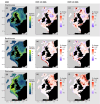Climate change affects the distribution of diversity across marine food webs
- PMID: 37814904
- PMCID: PMC10946503
- DOI: 10.1111/gcb.16881
Climate change affects the distribution of diversity across marine food webs
Abstract
Many studies predict shifts in species distributions and community size composition in response to climate change, yet few have demonstrated how these changes will be distributed across marine food webs. We use Bayesian Additive Regression Trees to model how climate change will affect the habitat suitability of marine fish species across a range of body sizes and belonging to different feeding guilds, each with different habitat and feeding requirements in the northeast Atlantic shelf seas. Contrasting effects of climate change are predicted for feeding guilds, with spatially extensive decreases in the species richness of consumers lower in the food web (planktivores) but increases for those higher up (piscivores). Changing spatial patterns in predator-prey mass ratios and fish species size composition are also predicted for feeding guilds and across the fish assemblage. In combination, these changes could influence nutrient uptake and transformation, transfer efficiency and food web stability, and thus profoundly alter ecosystem structure and functioning.
Keywords: biodiversity; climate change scenarios; ecosystem structure and function; fish feeding guilds; habitat suitability; species distribution modelling.
© 2023 Crown copyright. Global Change Biology published by John Wiley & Sons Ltd. This article is published with the permission of the Controller of HMSO and the King's Printer for Scotland.
Conflict of interest statement
The authors declare no conflict of interest.
Figures





References
-
- Brose, U. , Archambault, P. , Barnes, A. D. , Bersier, L. F. , Boy, T. , Canning‐Clode, J. , Conti, E. , Dias, M. , Digel, C. , Dissanayake, A. , Flores, A. A. V. , Fussmann, K. , Gauzens, B. , Gray, C. , Häussler, J. , Hirt, M. R. , Jacob, U. , Jochum, M. , Kéfi, S. , … Iles, A. C. (2019). Predator traits determine food‐web architecture across ecosystems. Nature Ecology and Evolution, 3(6), 919–927. 10.1038/s41559-019-0899-x - DOI - PubMed
-
- Butenschön, M. , Clark, J. , Aldridge, J. N. , Icarus Allen, J. , Artioli, Y. , Blackford, J. , Bruggeman, J. , Cazenave, P. , Ciavatta, S. , Kay, S. , Lessin, G. , Van Leeuwen, S. , Van Der Molen, J. , De Mora, L. , Polimene, L. , Sailley, S. , Stephens, N. , & Torres, R. (2016). ERSEM 15.06: A generic model for marine biogeochemistry and the ecosystem dynamics of the lower trophic levels. Geoscientific Model Development, 9(4), 1293–1339. 10.5194/gmd-9-1293-2016 - DOI
MeSH terms
Grants and funding
LinkOut - more resources
Full Text Sources

